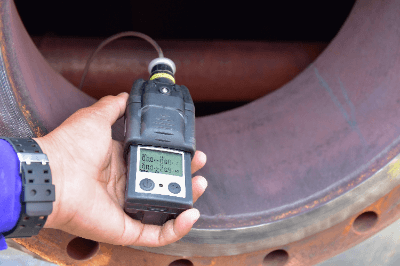What Is a Gas Detector?

A gas detector is a machine that measures the concentration of a target gas. There are various types of gas detectors, ranging from those used to detect gas leaks in homes to those used in industrial settings. All of these detectors are used to protect the safety of workers by alerting them to the presence of gases.
For residential use, the target gases are city gas and propane gas. For industrial use, detectors are used to measure oxygen concentration and detect toxic gases such as carbon monoxide and hydrogen sulfide, as well as flammable gases such as organic solvents.
Uses of Gas Detectors
Gas detectors are widely used in gas production, chemical plants, semiconductor factories, tunnel construction sites, the steel industry, agriculture, and homes. Gas leakage can cause a variety of hazards.
For example, leakage of flammable gases can lead to large-scale problems such as fires and explosions. Toxic gases can cause health hazards to workers and environmental pollution. Oxygen concentrations below a certain level can cause workers to die of asphyxiation.
Gas detectors are used to quickly detect and notify workers of gas leaks that could cause these serious accidents. Therefore, the appropriate type of gas detector must be selected for each application.
Types of Gas Detectors
1. Classification by type of object to be measured:
- Single-component gas detector: A single unit is used to measure one type of gas. Compact, lightweight, and easy to handle
- Combined gas detector: A single unit can be used to measure multiple types of gases. It can measure a wide range of gases, such as combustible gases, toxic gases, oxygen, etc., and is used at various factories and work sites to ensure safety.
2. Classification by installation method:
- Portable detectors: Portable detectors are worn by workers and used to measure gases during work and notify workers of an abnormality when a gas is detected.
- Stationary detectors: Continuously measure gas concentrations within a plant facility, contributing to stable plant operation. When used in large facilities, the detector and alarm sections/systems can be separated to monitor multiple locations at once.
Principle of Gas Detectors
Gas detectors can detect a wide range of gases and analyze them in a variety of ways. For many sensors, organosilicon gases, corrosive gases (SOx, NOx, etc.), and acidic gases (HF, HCl, etc.) are gases that cause deterioration (= miscellaneous gases). In addition, gases other than the target gases, such as hydrocarbons, alcohols, and organic solvents, can in many cases, interfere with accurate measurements (interference gases).
It is important to check in advance the type of sensor built into the detector you are considering using and the corresponding type of miscellaneous or interfering gases. The principle of each type of sensor and the gases to be measured are described below.
1. Semiconductor Type
This sensor uses the change in resistance that occurs when a semiconductor comes into contact with a gas. It has high sensitivity and can measure even low concentrations. Target: Flammable gases, toxic gases
2. Thermal Semiconductor Type
Instead of a semiconductor used in the semiconductor type, a platinum wire coil and a semiconductor are integrated. It is characterized by its high sensitivity and suitability for miniaturization. Target: Flammable gases, toxic gases
3. New Ceramic Type
This type utilizes the heat generated when combustible gas burns on a new ceramic (ultrafine particulate oxidation catalyst). It can measure a wide range of concentrations and is expected to operate stably. Target: Combustible gas
4. Catalytic Combustion Type
Platinum, an oxidation catalyst, is heated to a high temperature, and when gas strikes it, a combustion reaction occurs, and the temperature rises. This temperature change is used for detection. Excellent accuracy and reproducibility. Target: Combustible gas
5. Constant Potential Electrolysis Type
Detects the electric current generated when the gas is electrolyzed on the electrode. The target gas can be selected by setting the potential and is not easily affected by interfering gases. Target: Toxic gases
6. Diaphragm Galvanic Battery Type
A galvanic battery is built inside. When gas permeates through the diaphragm inside the battery, a reaction occurs between the two electrodes, generating an electric current. The strength of this current is used as the concentration of the target gas. The built-in battery can be operated without an external power supply. Target: Oxygen
7. Non-dispersive Infrared Type
Each type of gas has the property of absorbing infrared rays at specific wavelengths. The concentration of the gas is calculated from the amount of infrared radiation absorbed at the measurement wavelength. It can be operated stably over a long period and has high selectivity for the target of measurement. Target: Combustible gases, toxic gases
8. Lightwave Interferometry
Detects gases based on changes in the refractive index of the gas. It can be operated with stable accuracy for a long period. Object: Combustible gases
9. Thermal Conduction Type
The temperature of the detector element rises when the hot element comes into contact with the gas. The gas concentration is calculated from the value of the temperature change and the change in resistance of the element. Suitable for measurement of highly concentrated gases. Target: Combustible gases